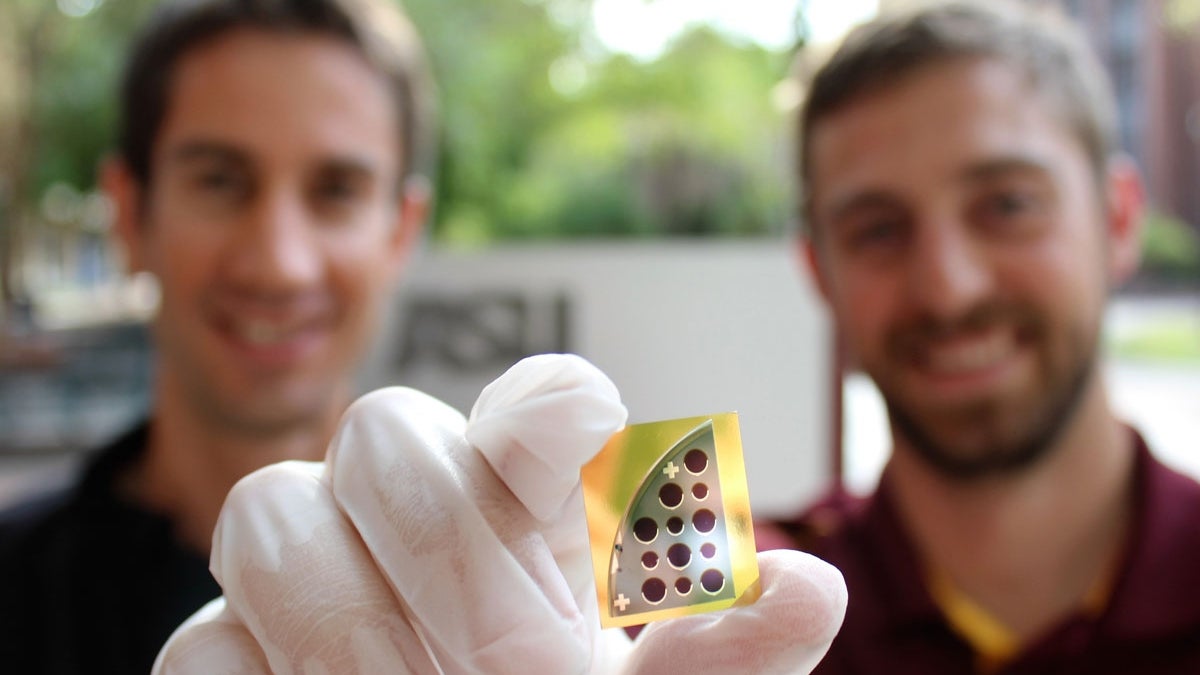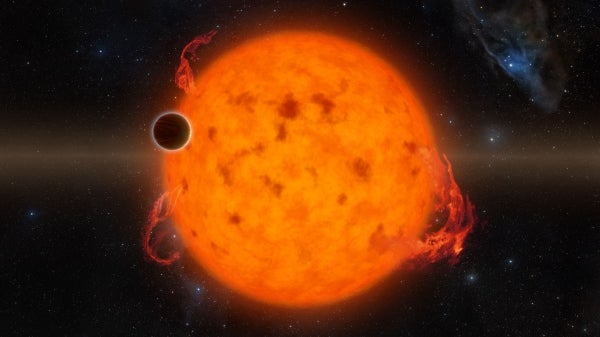ASU a power player at IEEE photovoltaics conference

Mathieu Boccard (left) and Jacob Becker (right) pose with a 17 percent cadmium telluride solar cell developed in tandem by Yong-Hang Zhang's and Zachary Holman's laboratories. Their research was presented at the IEEE Photovoltaic Specialists Conference, where ASU representatives won two Best Student Paper and two Best Poster awards. Photo courtesy of Zachary Holman
Arizona State University’s Ira A. Fulton Schools of Engineering had a standout showing among the top minds at the top international photovoltaic conference.
At the 43rd IEEE Photovoltaic Specialists Conference held in June in Portland, Oregon, Fulton Schools' faculty and students received the most recognition of any single institution for their photovoltaics research presentations.
“This is probably the most important conference in the field of photovoltaics science, and the fact that our students and faculty achieve recognition validates our work as a strong player in the field,” said electrical engineering assistant professor Mariana Bertoni, who has chaired in PVSC’s program committee for more than five years.
Researchers at the conference are asking and answering important questions in the field: How can we make solar both affordable and impactful? What are the benefits of using flexible materials? How can solar excel outside of the sunniest states?
ASU’s research addressed these questions from the fundamental to the product level.
ASU a top research institution at PVSC
More than 1,400 photovoltaics specialists presented their work at the conference, including 48 Fulton Schools' faculty members and students with 49 papers out of around 1,500 submissions — approximately 3 percent of the total submissions. However, these ASU representatives won far more awards than their representative share: two Best Student Paper out of total of 12, and two Best Poster awards. Additionally, seven ASU student papers were among Best Student Paper Finalists (Oral) and three were Best Poster Finalists.
“ASU is probably the largest publishing organization at PVSC for the past several years,” said Govindasamy Tamizhmani, solar energy associate research professor.
ASU has taken home Best Student Paper and Best Poster awards for the last six years in a row. This year, its two Best Student Paper awards were given for papers in the two largest technical areas — “Silicon Photovoltaic Materials and Devices” and “Chalcogenide Thin Film Solar Cells” — which account for half of all papers submitted to the conference’s 12 total technical areas. Each technical area awards only one Best Student Paper award.
“Our papers not only cover great science, but also offer practical approaches to solve existing challenges that industry is facing,” said Yong-Hang Zhang, electrical engineering professor and director of the ASU Center for Solid State Engineering Research/Nanofab.
The research presented in one Best Student Paper winner, “Monocrystalline CdTe/MgCdTe double-heterostructure solar cells with 1.096 V VOC and 17.0% efficiency” reported exciting new record performance of crystalline cadmium telluride solar cells.
These results come from a seamless collaboration between multiple research groups at ASU that harness complementary expertise in device theory, materials, cadmium telluride and silicon solar cells, and device testing.
The large research team consisted of two key students, electrical engineering doctoral students Yuan Zhao and Jacob Becker from Zhang’s group, electrical engineering post-doctoral research associate Mathieu Boccard from electrical engineering assistant professor Zachary Holman’s group, and an additional five students and a post-doc from these two groups.
A collaboration of energy engineering labs
ASU’s research came out of a culmination of faculty and students who work in several energy engineering laboratories at the university.
Tamizhmani is director of the Photovoltaic Reliability Laboratory at ASU, and his research focuses on the reliability of photovoltaic panels to predict their lifetime in a variety of climatic conditions using accelerated tests, field measurements and physical and statistical modeling.
The Defect Engineering for Energy Conversion Technologies Lab, of which Bertoni is principal investigator, performs research that is industrially relevant and works with companies in industry as well as other labs to solve fundamental problems that can have a near-term impact in the marketplace.
The Quantum Energy and Sustainable Solar Technology NSF-DOE Engineering Research Center focuses on creating solutions for the generation and distribution of photovoltaic solar energy in economically more viable and sustainable ways. Tamizhmani and Bertoni are faculty members of QESST along with Zhang, Holman and electrical engineering Professor Christiana Honsberg, who also presented at PVSC.
QESST is based in the School of Electrical, Computer and Energy Engineering and Honsberg serves as director and principal investigator. One of the ERC’s objectives is to motivate and educate students and the community to solve future energy challenges, and it trains teachers and faculty to improve the effectiveness of energy engineering education.
QESST research was involved in all four of ASU’s awards, and its university partners presented a total of more than 100 papers, which took home additional poster and presentation awards spanning several institutions nationwide.
With research centers like QESST at ASU, Fulton Schools faculty and students will continue to be leaders in the field.
“QESST’s presence at ASU not only elevates our standing as a major contributor to solar energy research and education, but attracts talent who will continue to make solar energy innovations for years to come, as evidenced by ASU’s exceptional showing at this year’s IEEE conference,” said Kyle Squires, dean of the Fulton Schools.
An opportunity for continued growth
The number of awards and quality of work presented at the conference shows the university is a top leader in the field with increasing influence for real impact.
Becker, who also received a Best Poster award for his research entitled, “Monocrystalline CdTe/MgCdTe double-heterostructure solar cells with a ZnTe hole-contact and passivation layer” is encouraged by the impact his work is having on the photovoltaics field.
“Receiving the award for best poster really lets me know that the work is appreciated by the community and that our results aren’t just presented to deaf ears but actually has an impact,” said Becker, a Dean’s Scholarship recipient at the School of Electrical, Computer and Energy Engineering. “The additional attention brought to the poster has already led to further outreach by fellow researchers to our team, the department and the school as a whole — a welcome benefit that can only help to improve our work in the future through additional collaboration on a national scale.”
ASU’s reputation in the photovoltaic community will lead to higher exposure to the research community and funding, and provide students with challenging research opportunities, award-winning publications and presentation experience in front of a large audience, Tamizhmani said.
More Science and technology

ASU forges strategic partnership to solve the mystery of planet formation
Astronomers have long grappled with the question, “How do planets form?” A new collaboration among Arizona State University,…

AI for AZ: ABOR funds new tools for state emergency response
A huge wildfire rages in the wilderness of Arizona’s White Mountains. The blaze scorches asphalt and damages area bridges,…

ASU researchers engineer product that minimizes pavement damage in extreme weather
Arizona State University researchers have developed a product that prevents asphalt from softening in extreme heat and becoming…